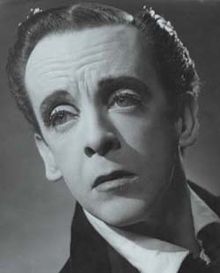Sir Robert Helpmann
| Sir Robert Helpmann CBE |
|
|---|---|

Portrait of Robert Helpmann in London circa 1945
|
|
| Born |
9 April 1909 Mount Gambier, South Australia, Australia |
| Died | 28 September 1986 (aged 77) Sydney, New South Wales, Australia |
| Occupation | Ballet dancer, actor, theatre director, choreographer |
| Years active | 1936–1986 |
| Partner(s) | Michael Benthall (1938–1974, his death) |
Sir Robert Helpmann CBE (9 April 1909 – 28 September 1986) was an Australian dancer, actor, theatre director and choreographer.
He was born Robert Murray Helpman (specifically spelt with one "n") in Mount Gambier, South Australia, and was known as "Bobby" by those close to him. Helpmann was educated at Prince Alfred College, Adelaide, but left school at 14. From childhood, Helpmann had a strong desire to be a dancer. This was an unusual ambition in provincial Australia of the 1920s. In a 1974 interview, Helpmann recalled that he was taught the moves and dances of a girl because his dance teacher had no prior experience teaching boys.
In the Margot Fonteyn biography, Helpmann is described as being dark-haired, pale and having large dark eyes. He had a younger sister Sheila Mary Helpman, and a younger brother Max, or Maxwell Gardiner Helpman, and he welcomed them both into his theatrical world, both of them becoming part of it like audience members and then becoming involved into his style of work as actors themselves.
In 1926 he joined the touring dance company of the Russian ballerina Anna Pavlova. The introduction came via his father, who was on a business trip to Melbourne, where he met Pavlova who was dancing there. One of the many versions of the cause for his decision to change his surname from Helpman to Helpmann, was that Pavlova, a devotee of numerology, suggested that he should change his surname to avoid his name Robert Helpman having 13 letters.
Following the wartime return of the Sadler's Wells Ballet from the newly occupied Netherlands, Helpmann took a central role in Ninette de Valois' new ballet of 1940, The Prospect Before Us.
The highpoint of Helpmann's career as a dancer was the Sadler's Wells Ballet tour of the United States in 1949, with Fonteyn and Helpmann dancing the leading roles in The Sleeping Beauty. The production caused a sensation, which made the names of both the Royal Ballet and its two principals; public and press alike referred to them affectionately as Bobby and Margot. Although Helpmann was past his best as a dancer, the tour opened doors for him in the United States as an actor and director.
...
Wikipedia
